
"Nearly famous since 2001"
The Mildred E. Jenson Collection
Page 2
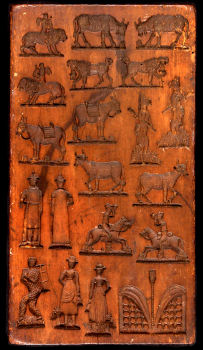 Marzipan board, front - 13 1/16" x 7 1/4" x 3/4" |
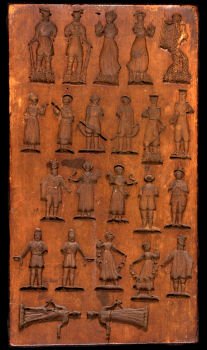 Marzipan board, back - 13 1/16" x 7 1/4" x 3/4" | |
This board contains 43 images. 42 of these will combine to make 21 3D images. Although this board could certainly be used for Springerle, I believe it was intended for marzipan work and most likely at one time had belonged to a confectionery. There are several very interesting images to look at. One in particular that I find intriguing is the "Cat Man" shouldering a weapon. Very interesting character. Does anyone know anything about him? The images are very detailed with eyes and hair but the board is dark so it is difficult to tell without holding it. The edges are well worn and there is the occasional worm hole. I am unsure of the age. By the dress I'm believing 19th Century. | ||
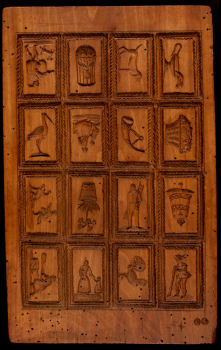 Persch, front - 13 1/2" x 8 1/2" x 15/16" |
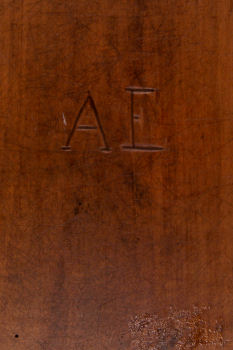 Persch, back - 13 1/2" x 8 1/2" x 15/16" | |
This mold has 16 pictures and carries the initials AE. It is made from nut or fruit wood and the detail work is first rate. The motifs are all great dealing with work, play, adventure, hunting and beauty. The carver of this mold had a bit of a playful side. On this board is hidden its date. Can you find it? | ||
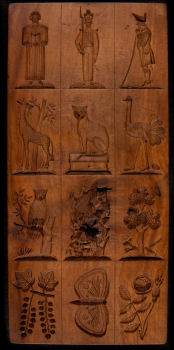 Mountain Goat - 9 5/8" x 4 5/8" x 15/16" |
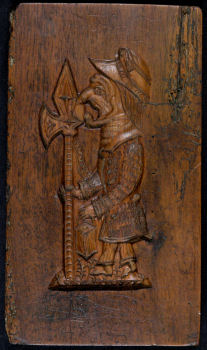 Mold "The Night Watchman" - 9" x 5 1/8" x 1 1/8" | |
The Night Watchman: This mold has a fair amount of worm damage but the image itself is free from damage. The surface is very slick and smooth. I'm told this may be a lebkuchen mold. I believe it would work well for Springerle also. I do not the type of wood but it has a great patina from decades of handling. It looks to be early 19th Century. | ||
Zeyher Mold, front - 4 15/16" x 4 7/8" x 1" |
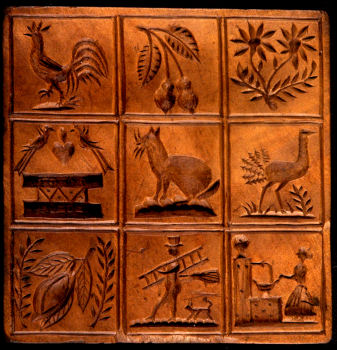 Zeyher Mold, back - 4 15/16" x 4 7/8" x 1" | |
 Zeyher Mold, signature |
This mold carries a signature and date. There are a total of 18 images with 9 on either side. The wood is fruit or nut. | |
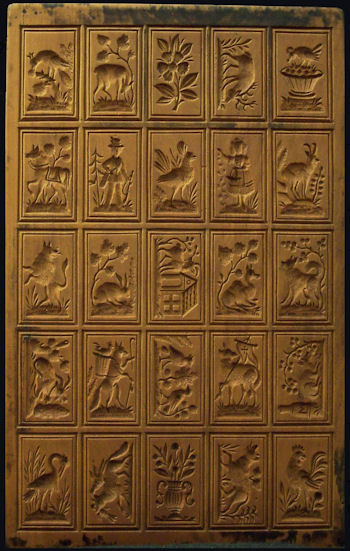 This mold measures 14 1/4" x 8 7/8" x 1" and contains 25 individual pictures. It is finely detailed with eyes, fur, feathers and petals being masterfully carved. This mold is from Southern Germany and is dated to between 1820 and 1830. |  Postage Stamp Mold - 10 11/16" x 6 3/8" x 11/16" This board is warped a bit and looks to be from the 19th century. On the side of this board is stamped "A Kempf. Nürnberg". I refer to this type of board as a "Postage Stamp" board. This is because all the images are about postage stamp size. A great one bite Springerle. This was an actual board from a bakery that has seen its share of use. The images are detailed and some are deep and contain meanings that I do not know at this time. | |
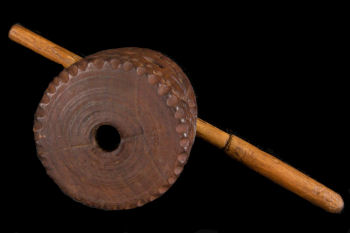 |
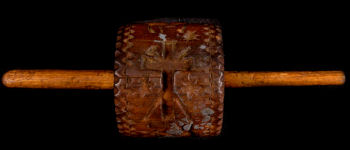 Persch Roller - this roller measures 1 7/8" and is 2 1/8" in diameter and the length of the handle is 6 3/4" | |
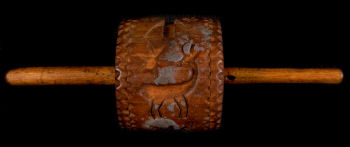 |
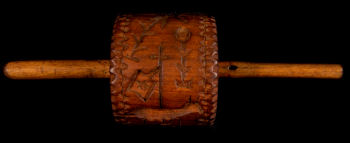 | |
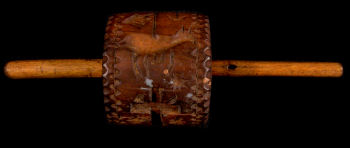 |
The "Persch Roller" is made from nut or fruit wood and the detail work is rustic. It is believed to be from between the late 18th century and the early 19th century. As you can see by the photos, the handle was held in place by a pin or other similar item. The motifs are a cross, the Easter Lamb a flower and a deer. It is well worn with a small split and also has some old paint on it. It has survived a mighty long time. | |
 |  | |
 |  | |
The above "Vino Pin" is carved from one piece of wood measures 12 1/4" long and is about 2" in diameter. This is a stunning rolling pin dating from about 1850. It is probably made from sycamore and would have been used for marking biscuits or pastry. It has 15 separate designs in rows of 3 all around the pin. The motifs include, leaves, flowers, geometric designs, thistle, anchor, pineapple etc. and on one row are the words UNION VIA WINE, these lead me to believe that this might well have come from either a College or ecclesiastical setting. | ||
Contact: Ken Hamilton
Email: ken@thespringerlebaker.com
Phone: 828-380-0578
Phone: 828-380-0578
Copyright: 2007 Ken Hamilton, TheSpringerleBaker.com |